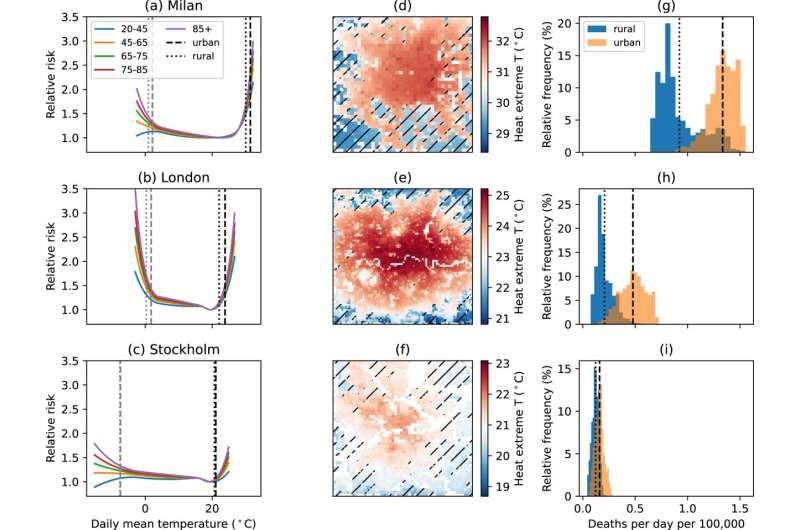This article has been reviewed according to Science X's editorial process and policies. Editors have highlighted the following attributes while ensuring the content's credibility:
fact-checked
peer-reviewed publication
trusted source
proofread
Urban heat islands have a health cost, reveals study

A new study led by EPFL has produced the first cost estimate of the impact that urban heat islands have on human health. The study looked at 85 European cities over the course of three full years, meaning it also took into account the protection that heat islands offer in winter—an aspect that has been little studied until now.
The findings are published in the journal Nature Communications.
The heat islands found in many European cities have a clear impact on human mortality risk—one that's comparable to air pollution, or in cost terms, the price paid by city dwellers for public transport. At least that's according to the study, which puts the average cost at €192 (approx. $210) for the heat-related effects per adult resident per year.
The work is the first to quantify the economic consequences of a problem that's common to many urban areas around the world but that scientists still struggle to grasp in all its complexity. To reach such straightforward, tangible figures, the research team combined data and methods from an array of disciplines including urban climatology, epidemiology, economics, statistics, and mathematical modeling.
"Our research shows that heat islands aren't just about people feeling too hot in the summer," says Gabriele Manoli, the study's corresponding author. "They also have significant adverse effects on human health, leading to increased cardiovascular and respiratory risks, for instance, and reducing overall life expectancy."
Manoli is a tenure-track assistant professor at EPFL and head of the Laboratory of Urban and Environmental Systems at EPFL's School of Architecture, Civil and Environmental Engineering (ENAC).
Potentially deadly, but also protective
The threats posed by urban heat obviously aren't the same depending on whether you're in Helsinki, Geneva or Madrid, and people living in Spain are clearly more accustomed to higher temperatures than those living in Finland. This study is the first to examine the effects of urban heat islands across different cities and seasons, compiling vast amounts of data and simulations in order to evaluate both the harm done by heat islands in the summer and the protection they offer during cold snaps in the winter.
For each city, the scientists estimated temperature-related risks and translated them into health costs, factoring in both summer and winter effects as well as the net annual effect. Little research has been done so far on the economic impact of urban heat risk and the role that heat islands play in the winter. This study puts the average "savings" at –€314 for the cold-related effects per adult resident per year. The scientists found that—for example—the urban heat island of Geneva can cause four additional heat-related deaths per 100,000 residents per year—but can prevent 3.4 cold-related deaths.
Making informed decisions
With this study, Manoli and his colleagues, who are based in the UK, the US and Singapore, hope their research will shed light on these important issues and inform future planning and climate mitigation strategies. Manoli explains that their interdisciplinary approach can help urban policymakers assess heat-related risks and juggle the many different factors associated with urban heat islands. "The goal is to make these areas less dangerous in the summer months without compromising the protection they can provide in winter," he says.
"Our study shows that the impact of heat islands varies considerably from one city and season to another. Going forward, policymakers can use this concrete information in their decision-making."
The full research paper contains tables listing all 85 cities included in the study along with their heat-island-induced mortality, number of years of life lost, and the estimated economic impacts. Taking Geneva again as an example, the net cost of heat-island-induced mortality was €20.7 per adult resident per year (€155 due to heat risk and –€134 due to cold weather), while in Trieste it was €184.4 (€547 and –€363 due to heat risk and cold weather, respectively).
Negative net cost
Some European cities even had a negative net cost, owing to the protection provided by heat islands over extended cold seasons. In Helsinki, for instance, there was a net savings of €113.9. However, the scientists stress that such figures shouldn't lull city planners into complacency about the dangers posed by extreme heat, since the effects are very harmful in the summer and will likely get worse in the future.
Manoli intends to take this research further by addressing the limitations of this initial study. For example, he plans to hone these first cost estimates by investigating the relationship among heat islands, social inequality, and transportation patterns.
More information: Wan Ting Katty Huang et al, Economic valuation of temperature-related mortality attributed to urban heat islands in European cities, Nature Communications (2023). DOI: 10.1038/s41467-023-43135-z





















